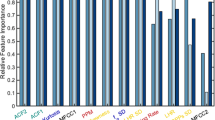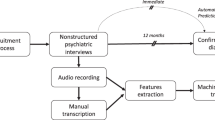Abstract
Speech patterns are argued to be promising diagnostic markers for neuropsychiatric conditions. However, most studies only compare one condition with healthy controls, which does not reflect the challenge faced in clinical practice. Here, to address this, we assessed recordings from 420 participants with major depressive disorder, schizophrenia, autism spectrum disorder and non-psychiatric controls. We trained and tested a variety of models on both binary and multiclass classification tasks using speech and text features. While binary classification models performed similarly to prior research (F1: 0.54–0.92), multiclass classification performance was markedly lower (F1: 0.35–0.75). By combining voice- and text-based models, relative overall performance improved by 9.4% F1 macro. Our findings suggest that binary models may not capture markers specific to individual conditions. Future research should aim to collect larger transdiagnostic datasets to capture the complexity of neuropsychiatric conditions.
This is a preview of subscription content, access via your institution
Access options
Subscribe to this journal
Receive 12 digital issues and online access to articles
$59.00 per year
only $4.92 per issue
Buy this article
- Purchase on Springer Link
- Instant access to full article PDF
Prices may be subject to local taxes which are calculated during checkout




Similar content being viewed by others
Data availability
Due to reasons of patient confidentiality and GDPR regulations, the raw data used for the present study (transcripts, audio recordings) cannot be shared. The output of all models is supplied in https://github.com/HLasse/multidiagnosis-speech for replication of the figures and tables in the paper.
Code availability
The code used for the analysis in the study can be found in the following two GitHub repositories: https://github.com/HLasse/multidiagnosis-speech/tree/main and https://github.com/rbroc/multidiagnosis-text/tree/master
References
MacFarlane, H., Salem, A. C., Chen, L., Asgari, M. & Fombonne, E. Combining voice and language features improves automated autism detection. Autism Res. 15, 1288–1300 (2022).
He, L. et al. Deep learning for depression recognition with audiovisual cues: a review. Inf. Fusion 80, 56–86 (2022).
Parola, A., Simonsen, A., Bliksted, V. & Fusaroli, R. Voice patterns in schizophrenia: a systematic review and Bayesian meta-analysis. Schizophr. Res. 216, 24–40 (2020).
Low, D. M., Bentley, K. H. & Ghosh, S. S. Automated assessment of psychiatric disorders using speech: a systematic review. Laryngoscope Investig. Otolaryngol. 5, 96–116 (2020).
Koops, S. et al. Speech as a biomarker for depression. CNS Neurol. Disord. Drug Targets 22, 152–160 (2023).
Fusaroli, R., Lambrechts, A., Bang, D., Bowler, D. M. & Gaigg, S. B. Is voice a marker for autism spectrum disorder? A systematic review and meta-analysis. Autism Res. 10, 384–407 (2017).
Hansen, L. et al. A generalizable speech emotion recognition model reveals depression and remission. Acta Psychiatr. Scand. 145, 186–199 (2022).
Kraepelin, E. Manic-Depressive Insanity and Paranoia (E. & S. Livingstone, 1921).
Hamilton, M. A rating scale for depression. J. Neurol. Neurosurg. Psychiatry 23, 56–62 (1960).
Fusaroli, R. et al. Toward a cumulative science of vocal markers of autism: a cross-linguistic meta-analysis-based investigation of acoustic markers in American and Danish autistic children. Autism Res. 15, 653–664 (2022).
Rybner, A. et al. Vocal markers of autism: assessing the generalizability of machine learning models. Autism Res. 15, 1018–1030 (2022).
Parola, A. et al. Speech disturbances in schizophrenia: assessing cross-linguistic generalizability of NLP automated measures of coherence. Schizophr. Res. 259, 59–70 (2022).
Parola, A. et al. Voice patterns as markers of schizophrenia: building a cumulative generalizable approach via a cross-linguistic and meta-analysis based investigation. Schizophr. Bull. 49, S125–S141 (2023).
Cummins, N. et al. A review of depression and suicide risk assessment using speech analysis. Speech Commun. 71, 10–49 (2015).
Nguyen, T., Phung, D., Dao, B., Venkatesh, S. & Berk, M. Affective and content analysis of online depression communities. IEEE Trans. Affect. Comput. 5, 217–226 (2014).
The ICD-10 Classification of Mental and Behavioural Disorders: Diagnostic Criteria for Research (World Health Organization, 1993).
American Psychiatric Association. Diagnostic and Statistical Manual of Mental Disorders: DSM-5 Vol. 10 (American Psychiatric Association, 2013).
Jensen, L. N. & Dwenger, N. MetaVoice. MetaVoice https://metavoice.au.dk/index.html (2022).
Eyben, F. & Schuller, B. openSMILE:): the Munich open-source large-scale multimedia feature extractor. ACMSIGMultimedia Rec. 6, 4–13 (2015).
Degottex, G., Kane, J., Drugman, T., Raitio, T. & Scherer, S. COVAREP—a collaborative voice analysis repository for speech technologies. In 2014 IEEE International Conference on Acoustics, Speech and Signal Processing (ICASSP) 960–964 (IEEE, 2014).
Voppel, A. E., de Boer, J. N., Brederoo, S. G., Schnack, H. G. & Sommer, I. E. C. Semantic and acoustic markers in schizophrenia-spectrum disorders: a combinatory machine learning approach. Schizophr. Bull. 49, S163–S171 (2022).
Vaswani, A. et al. Attention is all you need. In Advances in Neural Information Processing Systems Vol. 30 (Curran Associates, Inc., 2017).
LeCun, Y., Bengio, Y. & Hinton, G. Deep learning. Nature 521, 436–444 (2015).
Cummins, N., Baird, A. & Schuller, B. W. Speech analysis for health: current state-of-the-art and the increasing impact of deep learning. Methods 151, 41–54 (2018).
Baevski, A., Zhou, Y., Mohamed, A. & Auli, M. wav2vec 2.0: a framework for self-supervised learning of speech representations. Adv. Neur. In. 33, 12449–12460 (2020).
Devlin, J., Chang, M.-W., Lee, K. & Toutanova, K. BERT: pre-training of deep bidirectional transformers for language understanding. In Proc. 2019 Conference of the North American Chapter of the Association for Computational Linguistics: Human Language Technologies Vol. 1 (Long and Short Papers) 4171–4186 (Association for Computational Linguistics, 2019).
Ruder, S., Peters, M. E., Swayamdipta, S. & Wolf, T. Transfer learning in natural language processing. In Proc. 2019 Conference of the North American Chapter of the Association for Computational Linguistics: Tutorials 15–18 (Association for Computational Linguistics, 2019).
Forbes, M. K. et al. Elemental psychopathology: distilling constituent symptoms and patterns of repetition in the diagnostic criteria of the DSM-5. Elem. Psychopathol. https://doi.org/10.31234/osf.io/u56p2 (2023).
de Boer, J. N. et al. Acoustic speech markers for schizophrenia-spectrum disorders: a diagnostic and symptom-recognition tool. Psychol. Med. 53, 1302–1312 (2023).
Harrigan, J. A., Larson, M. A. & Pflum, C. J. The role of auditory cues in the detection of state anxiety 1. J. Appl. Soc. Psychol. 24, 1965–1983 (1994).
Amerman, J. D. & Parnell, M. M. Speech timing strategies in elderly adults. J. Phon. 20, 65–76 (1992).
Speechbrain. speechbrain/spkrec-xvect-voxceleb. Hugging Face https://huggingface.co/speechbrain/spkrec-xvect-voxceleb (2022).
Thompson, A. R. Pharmacological agents with effects on voice. Am. J. Otolaryngol. 16, 12–18 (1995).
Fried, E. I. Studying mental health problems as systems, not syndromes. Curr. Dir. Psychol. Sci. 31, 500–508 (2022).
Shaffer, R. C. et al. The relationship between expressive language sampling and clinical measures in fragile X syndrome and typical development. Brain Sci. 10, 66 (2020).
Rocca, R. & Yarkoni, T. Language as a fingerprint: self-supervised learning of user encodings using transformers. In Findings of the Association for Computational Linguistics: EMNLP 2022 1701–1714 (Association for Computational Linguistics, 2022).
Insel, T. et al. Research domain criteria (RDoC): toward a new classification framework for research on mental disorders. Am. J. Psychiatry 167, 748–751 (2010).
Ladegaard, N., Lysaker, P. H., Larsen, E. R. & Videbech, P. A comparison of capacities for social cognition and metacognition in first episode and prolonged depression. Psychiatry Res. 220, 883–889 (2014).
Ladegaard, N., Larsen, E. R., Videbech, P. & Lysaker, P. H. Higher-order social cognition in first-episode major depression. Psychiatry Res. 216, 37–43 (2014).
Beck, K. I. et al. Cross-cultural comparison of theory of mind deficits in patients with schizophrenia from China and Denmark: different aspects of ToM show different results. Nord. J. Psychiatry 74, 366–373 (2020).
Bliksted, V. et al. Hyper-and hypomentalizing in patients with first-episode schizophrenia: fMRI and behavioral studies. Schizophr. Bull. 45, 377–385 (2019).
Bliksted, V., Fagerlund, B., Weed, E., Frith, C. & Videbech, P. Social cognition and neurocognitive deficits in first-episode schizophrenia. Schizophr. Res. 153, 9–17 (2014).
Abell, F., Happe, F. & Frith, U. Do triangles play tricks? Attribution of mental states to animated shapes in normal and abnormal development. Cogn. Dev. 15, 1–16 (2000).
Sechidis, K., Fusaroli, R., Orozco-Arroyave, J. R., Wolf, D. & Zhang, Y.-P. A machine learning perspective on the emotional content of Parkinsonian speech. Artif. Intell. Med. 115, 102061 (2021).
Snyder, D., Garcia-Romero, D., Sell, G., Povey, D. & Khudanpur, S. X-vectors: robust dnn embeddings for speaker recognition. In 2018 IEEE International Conference on Acoustics, Speech and Signal Processing (ICASSP) 5329–5333 (IEEE, 2018).
Hansen, L., Olsen, L. R. & Enevoldsen, K. TextDescriptives: a Python package for calculating a large variety of metrics from text. J. Open Source Softw. 8, 5153 (2023).
Bojanowski, P., Grave, E., Joulin, A. & Mikolov, T. Enriching word vectors with subword information. Transactions of the Association for Computational Linguistics 5, 135–146 (2017).
Chen, T. & Guestrin, C. XGBoost: a scalable tree boosting system. In Proc. 22nd ACM SIGKDD International Conference on Knowledge Discovery and Data Mining 785–794 (Association for Computing Machinery, 2016).
Babu, A. et al. XLS-R: Self-supervised cross-lingual speech representation learning at scale. In Proc. Interspeech 2022 2278–2282 (ISCA, 2022).
Conneau, A. et al. Unsupervised Cross-lingual representation learning at scale. In Proc. 58th Annual Meeting of the Association for Computational Linguistics 8440–8451 (Association for Computational Linguistics, 2020).
Reimers, N. & Gurevych, I. Making monolingual sentence embeddings multilingual using knowledge distillation. In Proc. 2020 Conference on Empirical Methods in Natural Language Processing (EMNLP) 4512–4525 (Association for Computational Linguistics, 2020).
Abayomi-Alli, O. O., Damaševičius, R., Qazi, A., Adedoyin-Olowe, M. & Misra, S. Data augmentation and deep learning methods in sound classification: a systematic review. Electronics 11, 3795 (2022).
Acknowledgements
We acknowledge seed funding from the Interacting Minds Centre (‘Clinical voices’). R.R. is partly supported by funding from the Volkswagen Stiftung. A.P. was supported by Marie Skłodowska-Curie Actions—H2020-MSCA-IF-2018 grant (ID: 832518, Project: MOVES). D.B. is supported by a Lundbeck Foundation Fellowship (R368-2021-325).
Author information
Authors and Affiliations
Contributions
L.H., R.R. and R.F. conceived and conceptualized the research idea, and developed the analysis plan. A.S., A.P., V.B., N.L., D.B., K.T., E.W. and R.F. collected the data; L.H., R.R. and L.O. cleaned and preprocessed the data; and L.H. and R.R. conducted the data analysis. L.H., R.R. and R.F. drafted the paper. A.S., L.O., A.P., V.B., N.L., D.B., K.T., E.W. and S.D.Ø. reviewed the paper and provided critical comments. R.F. supervised and administered the project.
Corresponding author
Ethics declarations
Competing interests
S.D.Ø. received the 2020 Lundbeck Foundation Young Investigator Prize. Furthermore, S.D.Ø. owns/has owned units of mutual funds with stock tickers DKIGI, IAIMWC, SPIC25KL and WEKAFKI, and has owned units of exchange traded funds with stock tickers BATE, TRET, QDV5, QDVH, QDVE, SADM, IQQH, USPY, EXH2, 2B76 and EUNL. R.F. has been a paid consultant for F. Hoffman-La Roche. L.H. has been an intern at F. Hoffman-La Roche. The remaining authors declare no competing interests.
Peer review
Peer review information
Nature Mental Health thanks Heather MacFarlane, Alban Voppel and the other, anonymous reviewer(s) for their contribution to the peer review of this work.
Additional information
Publisher’s note Springer Nature remains neutral with regard to jurisdictional claims in published maps and institutional affiliations.
Supplementary information
Supplementary Information
Supplementary Tables 1–9, animated triangles task, data processing, models and Fig. 1.
Rights and permissions
Springer Nature or its licensor (e.g. a society or other partner) holds exclusive rights to this article under a publishing agreement with the author(s) or other rightsholder(s); author self-archiving of the accepted manuscript version of this article is solely governed by the terms of such publishing agreement and applicable law.
About this article
Cite this article
Hansen, L., Rocca, R., Simonsen, A. et al. Speech- and text-based classification of neuropsychiatric conditions in a multidiagnostic setting. Nat. Mental Health 1, 971–981 (2023). https://doi.org/10.1038/s44220-023-00152-7
Received:
Accepted:
Published:
Issue Date:
DOI: https://doi.org/10.1038/s44220-023-00152-7
This article is cited by
-
Relative importance of speech and voice features in the classification of schizophrenia and depression
Translational Psychiatry (2023)



